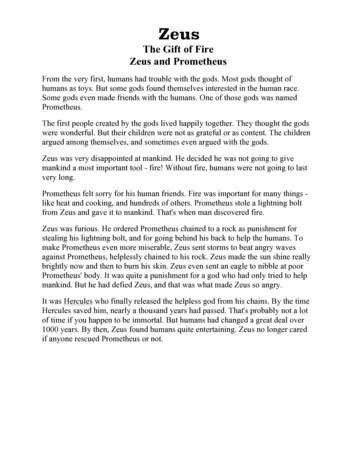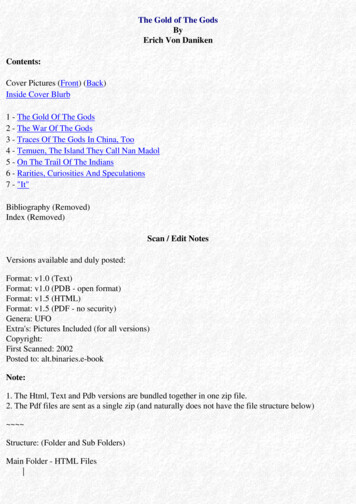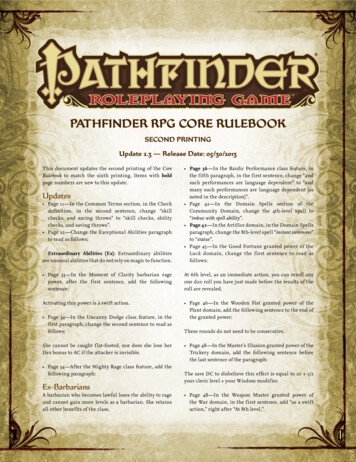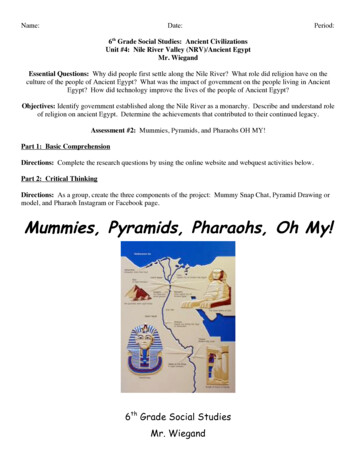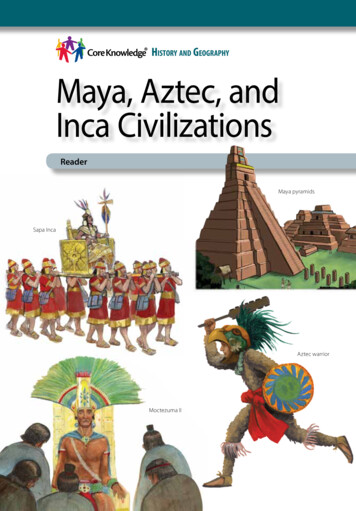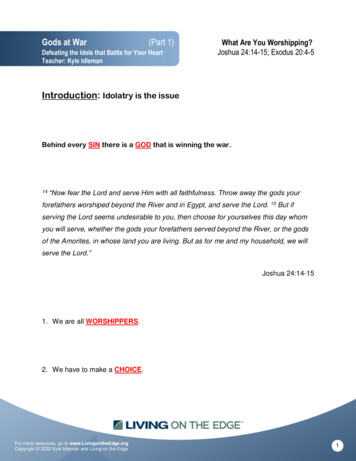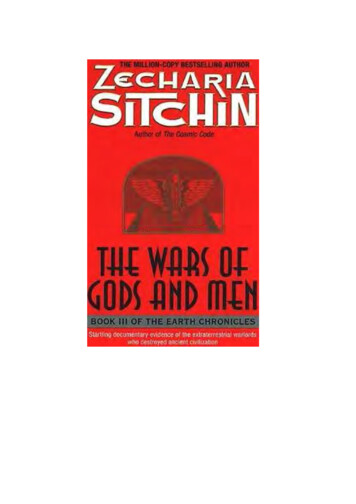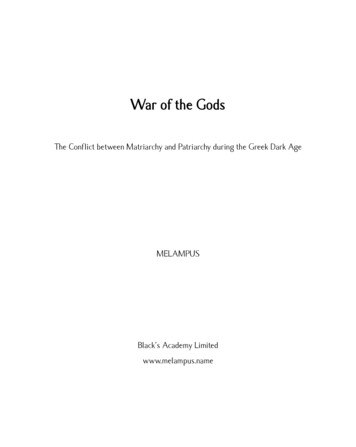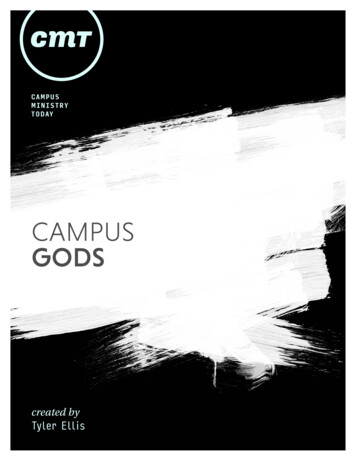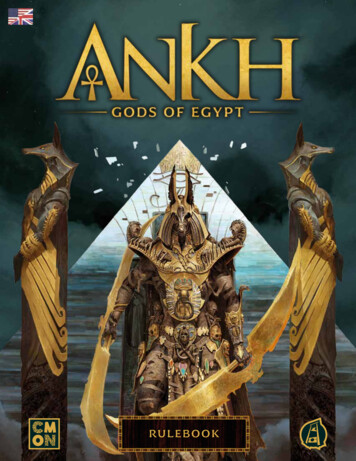
Transcription
RULEBOOK
TABLE OF CONTENTSOVERVIEW. 2INTRODUCTION. 3COMPONENTS. 4BASIC CONCEPTS. 7Adjacency.8Figures.8Monuments.8Central Dashboard. 9God Dashboard. 10Devotion.11Battle Cards.11SETUP.12WINNING THE GAME.13GAMEPLAY.13ACTIONS.14OVERVIEWMove Figures.15Summon Figure.16Gain Followers.17Unlock Ankh Power.18Controlling Guardians.18EVENTS.19Control Monument. 20Ankh - Gods of EgyptCamel g Gods.25Merged God Gameplay.26Ankh: Gods of Egypt is a competitive game for 2–5 players set inancient mythical Egypt during the transition from polytheismto monotheism.Each player controls an ancient Egyptian god, and their goal isto gather enough Devotion to become the only god of Egypt.Devotion is gained by having Monuments in your honor andengaging in conflicts with the other gods for dominion over thekingdom. To do so you will need to gather Followers, sacrificingthem to build Monuments or increase your god’s Ankh powers.As time advances, monuments may become associated withdifferent gods, mythical Guardians will join the conflict,regions of Egypt will be redivided by camel caravans, and twogods may even merge into a new divine being, but only one(or perhaps none) will rise in the end as the only God of Egypt!Forgotten Gods.27CARDS AND POWERS.28Ankh Powers.28Battle Cards.29The Gods Of Egypt. 30The Guardians of Mankind.31CREDITS.31RULES SUMMARY.32FREE DIGITAL CONTENTGET ITHERE!CMON.COM/Q/ANK001/R
IntroductionIn ancient times, along the mighty Nile, the people had grown strong, fedby its waters and nourished by its blessings. As the people flourished,so too did their gods. The people built monuments, made sacrifices,and venerated their deities. In turn, the gods granted them knowledge,tools, and wealth. But some gods fared better than others.The gods had never been creatures of brotherhood amongst themselves,and now, with their very existence threatened, the mightiest deities ofEgypt gather their strength, marshal their devoted, and march to war.In the end, when the sand settles, the blood dries, and thewinds becalm to gentle breezes, only one god will emergetriumphant in the new age of monotheism. Who will it be?Gods of Egypt - AnkhThose receiving constant devotion grew mighty, potent, and influential.They could stretch forth their hand and change the world at a whim.Those whose names no longer graced the people’s lips, their formswithered, their steps faltered, and their powers diminished. Changehad come to the land of the Nile. And with change came war.3
COMPONENTS1x Anubis God6x AnubisWarrior1x Amun God6x AmunWarrior1x Osiris God6x OsirisWarrior10x Large Base(2 per God)Ankh - Gods of Egypt1x Isis God46x IsisWarrior3x Mummy1x Ra God6x RaWarrior10x Small Base(2 per God)2x Giant Scorpion2x Apep2x Androsphinx3x Satet3x Cat-Mummy30x Camel
1 DevotionDashboard1 Game Board1 CentralDashboard5 God Dashboards5 Player Aid Cards35 Battle Cards (7 per God)Gods of Egypt - Ankh5 Merged God Dashboards5
6 Guardian Reference Cards75 Ankh Tokens(15 per god)5 Plastic AnkhTokens (1 per god)70 FollowerTokens1 Plastic EventTracker4 Action Markers10 Pyramid Tokens10 Temple Tokens10 Obelisk Tokens4 Action MarkerPlastic BasesAnkh - Gods of Egypt1 Amun Token63 Sun Tokens8 Conflict OrderTokens2 City Tokens1 Battle TiebreakerToken3 UnderworldTokens1 ScenarioBook1 Rulebook
BASIC CONCEPTSGAME BOARDThe game board in Ankh: Gods of Egypt depicts ancientEgypt, where the mighty Nile river divides the land intothree distinct regions: the Nile Delta, East Egypt, and WestEgypt. Some game scenario setups, as well as in-gameevents, will place Camel Caravans that subdivide theseregions into two or more smaller regions which can greatlyalter the balance of power amongst the gods. Each regionon the game board consists of hexagon-shaped spaces,which may be either Fertile (green) or Desert (yellow).Each space can be either empty or occupied by exactly 1figure or Monument at a time. The blue spaces are Waterand cannot normally be occupied. Water spaces count aspart of each region they are adjacent to and are consideredadjacent to all spaces surrounding them. Throughout thegame, Conflicts will take place in each region as the godsstruggle to become the only God of Egypt.RiverNile DeltaRegionFertileSpaceDesertSpaceEast EgyptRegionWaterSpaceMapEdgeGods of Egypt - AnkhWest EgyptRegion7
ADJACENCYFigures and Monuments are adjacent to each other if theyoccupy spaces that share a hex border and are both in thesame region. Spaces divided by a river or camel are notadjacent. This applies to ALL cases where the term adjacentis used.Warriors: Each god has a personal army of 6 Warriors thatcan fight battles and control strategic areas.Guardians: There are many legendary creatures and minordeities that will serve any god that displays sufficient power.Each Guardian has a unique ability and also provides strengthin battle. Players can gain control of these Guardians byunlocking Ankh powers (see page 18).Example: The Warrior is adjacent to the Pyramid, but notto the Giant Scorpion, which is in a different region.FIGURESAnkh - Gods of EgyptEach God of Egypt is represented by a large figure and isaccompanied by its own group of Warriors. During thegame, players can also gain control of mythical beings calledGuardians. When not in use, your figures are kept in yourpool next to your God dashboard.8Each figure has a basic strength of 1, but individualGuardian abilities, God powers, or Ankh powers mightincrease this amount.Camel caravans are used to divide the game board intodifferent regions. It’s important to note that even thoughcamels are represented with sculpted plastic pieces, theyare not considered figures for the purpose of game rules,and they are not controlled by any player.MONUMENTSEgyptian gods draw power from monuments, and controllingmonuments attracts a god more Followers, which are vitalfor further increasing a god’s power. There are 3 types ofMonuments: Obelisks, Temples, and Pyramids. A Monumentis controlled by a god if it has one of that god’s Ankh tokensattached to it. Each Monument can only be controlled by onegod at a time. A Monument without any Ankh token on it is aneutral Monument.ObeliskGods: The Gods of Egypt are powerful immortals, each withunique abilities. GODS CAN NEVER BE KILLED! Even if aneffect indicates that all figures are killed, God figures areexempt from that.PyramidTemplePlayers use their Ankh tokens to markwhich Monuments they control.
CENTRAL DASHBOARDDuring the game, players take turns performing actionsincluding moving their figures on the board to seize controlof key territory, summoning Warriors and Guardians to battletheir opponents, gaining new Followers, and unlocking newAnkh powers. The 4 possible actions are depicted on the tophalf of the Central Dashboard as separate Action tracks,each with their own Action marker. Each time a playerperforms a particular action, that Action marker is moved 1space to the right along its track. The actions are explainedfully on page 14. When an Action marker reaches the end ofits track, an event is triggered.Note: The starting position of each Action marker is dependenton the number of players at the beginning of the game. Forexample, in a 3-player game, set up each Action marker onthe “3” space, as shown in the diagram below. Whenever anAction marker reaches the end of its Action track, an event istriggered and the Action marker resets to its starting position.Tip: To help avoid mistakes, you may use the Ankh tokens ofan unused god to cover the leftmost spaces that can’t be used.The Event track is the other feature of the CentralDashboard, and it serves as the game’s timeline. When aplayer’s chosen action triggers an event, the Event markeris advanced 1 space along the Event Track, which triggers aspecific event. These are explained in detail on page 19.Action markerstarting positionsfor 5, 4, 3, or2-player gamesControl MonumentEventCamel CaravanEventGods of Egypt - AnkhConflict Event9
GOD DASHBOARDEvery god of Egypt has its own dashboard that describesits divine nature. Each god has a unique God ability that isavailable from the start of the game. As the game progressesand the gods acquire new Followers, they can unlock Ankhpowers that grant them new capabilities. The 12 possibleAnkh powers are grouped into 3 levels and arrangedaccordingly into 3 columns on the God dashboard. A godmay have up to 2 Ankh powers unlocked in each column (twolevel 1 powers, two level 2 powers, and two level 3 powers).Unlocking Ankh powers can also attract the service oflegendary Guardians (see page 18).Unlocked Ankh PowerAnkh - Gods of EgyptGod Ability10GuardianSymbolLocked Ankh PowerAnkh PowerLevel
DEVOTIONDevotion is the measure of how much a god is worshippedby the people of Egypt. Each god’s current Devotion levelis marked with an Ankh token on the Devotion dashboard.Each god begins the game at the bottom of the Devotiontrack (the lowest red space), and as they earn more Devotion,their Ankh token is moved up the track. If a god reaches thetop space on the Devotion track, they immediately win thegame. On the other hand, any god who fails to earn enoughDevotion to move beyond the red spaces by the end of the4th Conflict event will be forgotten and eliminated from thegame.If multiple Ankh tokens are stacked onthe same space of the Devotion track,the order of the stack from top to bottomindicates which god has more devotionthan the others sharing that space, withthe token on top of the stack representingthe most Devotion and the one of the bottom representingthe least Devotion in that space. When a god’s Ankh tokenenters a space occupied by other tokens, the new tokenalways goes on the top of the stack.IMPORTANT: Whenever multiple players would gain or loseDevotion at the same time, start with the player with the leastDevotion and proceed in ascending order until the player withthe most Devotion.BATTLE CARDSEach player uses their own set of 7 Battle cards. Thesecards are used during Conflict events and provide a bonusto a player’s battle strength along with a special effect. Theplayers don’t get back their used Battle cards automatically.They remain faceup on the table for all players to see, sochoosing the right card at the right moment is pivotal.Card TitleBattleStrengthBonusGods of Egypt - AnkhEffect11
SETUP6711951031Ankh - Gods of Egypt212 1 Each player chooses one of the mighty gods of Egyptfrom among those available and takes the followingcomponents belonging to that god: God figure 6 Warrior figures God dashboard Merged God dashboard Ankh tokens Set of 7 Battle cards Player Aid card If a player has Ra, they take the 3 Sun tokens. If aplayer has Osiris, they take the 3 Underworld tokens.If a player has Amun, they take the Amun token. 2 Each player starts with 1 Follower token. Set the remainingFollower tokens aside in a general supply where all playerscan reach them.IMPORTANT: Followers are not limited. If you run out of them,you can use any replacement.3 Each player places 6 of their Ankh tokens on their god1.dashboard in the spaces along the bottom row belowthe locked Ankh powers. They keep their remaining Ankhtokens near them, forming a personal Ankh token pool.
4 Randomly determine a first player (or assign it to theplayer who owns the most cats). Other players will followin clockwise seating order around the table. 5 In reverse player order, starting with the last player, eachplayer places their plastic Ankh token on the bottomspace of the Devotion track, forming a stack. In this way,the first player’s Ankh token should be on top, startingwith the most Devotion. 6 Place the 4 Action markers on the Action tracks of thecentral dashboard in the starting spaces matching thenumber of players in the game. 7 Place the Event marker on the first space of the Events track. 8 Choose a scenario from the scenario book (either agreedupon by all players or picked randomly). Each scenario listspossible player counts. Make sure the chosen scenario ispossible with the number of players. 9 Place Monuments (Pyramids, Temples, and Obelisks),Conflict Order tokens, and Camels on the board asshown in the scenario setup diagram (not all scenarioswill require you to place camels). Set the remainingMonuments, Conflict Order tokens, Battle Tiebreakertoken, and Camels aside in the general supply.WINNING THE GAMEThere are 3 ways to become the only God of Egypt and winthe game: A player wins immediately when their Ankh tokenreaches the top space of the Devotion track. A player wins immediately if they are the only godleft in play after the 4th Conflict event. (If no gods areleft in play at this stage, the game ends in a draw andEgypt becomes atheistic.) If neither of the previous conditions are met, thegame is won by the player with the most Devotionafter the last Event on the track is resolved.GAMEPLAYAnkh is played in turns. During their turn, a player performs1 or 2 actions. Sometimes, a player’s action will also triggeran event. After fully resolving the player’s action(s) and theevent (if one was triggered), the current player’s turn endsand the next player in clockwise order takes their turn.Note: Conflict Order tokens don’t belong to a specific space onthe board. They are assigned to an entire region.10 Place your figures and Ankh tokens (on your controlledMonuments) on the board as shown in the scenario setup.The first player is player #1 in the scenario setup, theplayer to their left is player #2, and so on.12 Follow any Additional Setup Rules as dictated in thescenario book.You are ready to play!Gods of Egypt - Ankh 11 Choose (either agreed upon by all players or pickedrandomly) one Level 1, one Level 2 and one Level 3Guardian card and place them near the game board. Then,place a number of their Guardian figures next to the cardsaccording to the number of players: 2 Players: Use 1 Guardian figure of each type 3 Players: Use 2 Guardian figures of each type 4 or 5 Players: Use all available Guardian figures ofeach type (3 for small-base Guardians, 2 for largebase Guardians).13
ACTIONSThere are 4 possible actions a player can take during their turn: Move Figures Summon Figure Gain Followers Unlock Ankh PowerEach action is displayed as a track on the central dashboard.To choose an action, the player slides the correspondingAction marker 1 space to the right on its track, then performsthat action in its entirety. A player is allowed to choose anAction even if they cannot resolve it.If the chosen Action marker reaches the rightmost space ofits track (white background), an event is triggered.1Ankh - Gods of Egypt21434First, completely resolve the player action that triggered the event.Then, resolve the event itself by advancing the Event marker 1space to the right on the Event track. After resolving the event,return the Action marker to its starting position on its Action track(the space that matches the number of players in the game at thestart of the game). Events are fully explained on page 19.IMPORTANT: If a player triggers an event with their firstaction, they are not allowed to take a second action.After performing their first action, if the player did not triggeran event, they must choose a second action. The secondaction must be in a lower line of the central dashboard thanthe first chosen action.NOTE: Even if they cannot resolve their second action for somereason, the player must still move its Action marker. The onlycases in which a player moves a single marker on their turn is ifthey trigger an event with their first action, if their first action isUnlock Ankh Power, or if they are Merged (see page 25).Example: The Amun player chosesSummon Figure as their first action andmoves that Action marker 1 space to theright 1 . As their second action, theycan choose either Gain Followers 2 orUnlock Ankh Power 3 , but they cannotchoose Move Figures, since that actionis above Summon Figure. They alsocannot choose Summon Figure again. Ifthey choose Unlock Ankh Power, afterresolving it, they will trigger a Conflictevent 4 .
MOVE FIGURESPositioning your figures correctly is vital if you are going totake full advantage of each region. Many situations in the gamerequire figures to be adjacent to another figure or Monument.Other times, it can be very advantageous to simply occupy aspace so that your opponents may not do so.When performing the Move Figures action, the player maymove each of their figures on the board 1, 2, or 3 spaces.Figures can move across spaces occupied by figuresbelonging to any player or by Monuments or any othertokens, across Water spaces, or cross Rivers and CamelCaravans, but they must end their movement in an emptyspace that is not a Water space. Each space on the board canonly be occupied by 1 figure or 1 Monument at a time.Note: Monuments do not change control because ofmovement. Players gain (or lose) control of Monuments duringControl Monument events.2143 The player would like to move their Warrior to aspace adjacent to the neutral Temple, but Ra’s figuresare blocking the destination spaces, so they only movetheir Warrior 2 spaces, moving over a Ra Warrior andthe River. Finally, 4 they decides not to move their lastWarrior at all.Gods of Egypt - AnkhExample: The Amun player performs a Move Figuresaction and 1 moves their God figure 3 spaces, throughone of their Warriors, and ending adjacent to the neutralObelisk. Then, 2 they move a Warrior 3 spaces, endingadjacent to the neutral Pyramid. The Warrior is allowed tomove through the Water space and through the Pyramidbecause it ended its movement in an empty space.315
SUMMON FIGUREThe gods wield immense power, but even they need supportfrom Warriors and Guardians to spread their domain acrossthe land.The Summon Figure action allows a player to choose 1 figurefrom their pool (Warrior or Guardian) and place it on the gameboard. This figure must be placed in an empty, non-Water spaceadjacent to one of that player’s figures already on the board, oradjacent to a Monument that player controls (remember thatadjacency requires them to be in the same region).232232Ankh - Gods of Egypt216212Example: The Amun player performs a Summon Figureaction and places a Mummy from their pool into anempty space adjacent to the Temple they control 1 . TheAmun player could have chosen any space marked 2in the diagram above because those spaces are emptyand adjacent to other Amun figures or to the Templecontrolled by Amun. They couldn’t choose the spacesmarked 3 because they are not in the same region asthe Warrior, and so not adjacent to it.
GAIN FOLLOWERSEvery divine being needs Followers to do their bidding.Followers are key to building new Monuments to honor thegods and for unlocking Ankh powers.When performing a Gain Followers action, the player gainsa number of Followers equal to the number of Monuments(either under their control or neutral) they have any figuresadjacent to. They take that number of Follower tokens fromthe general supply and add them to their pool.425163gain a Follower from the Pyramid they control 4 asthey have no figures adjacent to it; nor from the neutralPyramid 5 , since their Warrior is in a different region,and so not adjacent to it. They also do not gain a Followerfrom 6 , because that Obelisk is controlled by Amun.Gods of Egypt - AnkhExample: In the diagram above, the Isis player performs aGain Followers action and gains a total of 3 Followers fromthe following Monuments: The Obelisk they control 1 ,the neutral Temple adjacent to their Warrior 2 , and theneutral Pyramid adjacent to their Warrior 3 . They don’t17
UNLOCK ANKH POWERA player’s God dashboard shows all of the possible Ankhpowers available. Ankh powers can only be used after theyhave been unlocked by performing the Unlock Ankh Poweraction. Ankh powers are divided into 3 levels and displayedon the God dashboard in 3 columns. At most, each god mayhave 2 Ankh powers unlocked in each level.The Ankh tokens used to mark unlocked Ankh powers sit in arow at the bottom of the God dashboard, with 2 Ankh tokensin each column. Each time a player performs an Unlock AnkhPower action, they move the leftmost Ankh token in thisbottom row up to the Ankh power of their choice within thesame column. This means two Level 1 Ankh powers must beunlocked before a Level 2 power can be unlocked, and so on.Each time an Ankh power is unlocked, the player mustsacrifice a number of their Followers equal to the level ofthe Ankh power they are unlocking (1, 2, or 3). SacrificedFollowers are taken from a player’s pool and returned to thegeneral supply.Ankh - Gods of EgyptIf a player doesn’t have enough Followers, or has alreadyunlocked all of their Ankh Powers, they may still take thisaction, moving the Action marker but gaining no benefitfrom it (without sacrificing any Followers).18Example: The Amun player performs an Unlock AnkhPower action. The leftmost Ankh token at the bottomof their God Dashboard is in the Level 1 column, so theysacrifice 1 of their Followers to unlock a Level 1 AnkhPower. They choose to unlock Inspiring and move theControlling GuardiansSometimes when a player performs an UnlockAnkh Power action, they reveal a Guardiansymbol on their God dashboard. This signifiesthat the god has acquired sufficient power toattract a Guardian into its service.When a player uncovers a Guardian symbol on the Level 1column of their God dashboard, they gain control of 1 figurefrom the Level 1 Guardian card and adds it to their pool.Likewise, when they uncover the Level 2 Guardian symbol,they gain control of a Level 2 Guardian, and so on. In eachcase, if there are no more figures available on that Guardiancard, the player gains nothing.When a player adds a Guardian figureto their pool, they attach one of theircolor bases of the appropriate sizeto that figure. This will make it clearwhich player controls a specificGuardian when it is on the board. Ifthe player doesn’t have a spare baseof the appropriate size, they can’t takethe Guardian figure. Guardians in aplayer’s pool can be summoned to theboard with the Summon Figure action.leftmost Ankh token up to that space. By doing so, theyreveal a Guardian symbol, which gives them control ofa Level 1 Guardian figure. They add this newly-acquiredfigure to their pool, with a color base attached.
EVENTSAs the struggle between the gods unfolds, momentousevents mark the passage of time. Monuments are erected,caravans divide the land, and violent conflicts change thebalance of power. All of these events are represented on theEvent track, which serves as the game’s timeline.When an Action marker reaches the rightmost space in itstrack, after resolving the action, an event is triggered. Movethe Event marker to the next space on the Event track. Then,resolve the event depicted in that space. There are twotypes of event spaces: individual events (round spaces) andconflicts (square spaces). Individual events only involve theplayer that triggered the event. Conflicts, on the other hand,will involve all players.After the event is resolved, the Action marker resets to thespace matching the number of players that started the game.132resolving the event, the Gain Followers Action marker isreturned to its starting position on the Action track (inthis case, the space corresponding to a 3-player game)3 . The player can’t perform a second action since anevent was triggered, so their turn is over.Gods of Egypt - AnkhExample: As their first action, the Isis player performsGain Followers, which moves that Action marker to therightmost space on its Action track 1 . After completelyresolving the Gain Followers action, the Isis playermoves the Event marker 1 space along the Event track,which triggers a Control Monument event 2 . After19
CONTROL MONUMENTMonuments are key strategic features onthe game board. They are the main sourcefor gaining Followers, they help the godsestablish footholds around the land, and maybe bolstered by Ankh powers.When a player triggers a Control Monument event, they gaincontrol of 1 neutral Monument of their choice, as long asthey have at least 1 figure adjacent to that Monument. Theplayer places one of their Ankh tokens from their pool on theMonument to indicate their control.If there are no neutral Monuments left on the boardwhen this event is triggered, the player gains control of aMonument controlled by another player instead. The playerwho triggered the event must still have at least 1 figureadjacent to the Monument they wish to control. If theydo, they remove that other player’s Ankh token from themonument (returning it to that player’s pool) and replace itwith one of their own.If the player is not adjacent to a valid Monument, or if theydon’t have any Ankh tokens in their pool, they don’t gain anybenefit from resolving this event (though the Event trackeris still moved).41Ankh - Gods of Egypt2203Example: The Isis player has triggered a ControlMonument event. They have a Warrior adjacent to aneutral Temple 1 so they can choose to gain control ofit. They cannot choose the neutral Pyramid 2 becauseit is in a different region than their figure and so notadjacent. They also cannot choose to gain control ofthe Obelisk controlled by Ra 3 because there are stillneutral Monuments on the board. The Isis player takescontrol of the neutral Temple and places an Ankh tokenfrom their pool on it 4 .
CAMEL CARAVANBy deploying grand caravans of camels, thegods are able to redraw the borders thatdivide the land. The Camel Caravan eventallows a player to split a region into 2 newsmaller regions, shifting the balance of powerand disrupting their opponents’ plans.The player that triggered the Camel Caravan event can placea line of up to 6 camels, from the general supply, onto theboard. Camels are placed on the lines that separate thespaces, 1 Camel per hexagon side (not on Rivers or Waterspaces). The player must place a line of Camels connectingtwo of the following features on the game board: Rivers,Water spaces, other Camels, or external map borders. Bothnew regions created by this division must be at least 6spaces in size (not counting Water spaces).After splitting a region into two new regions, the playerchooses one of the new regions to keep the Conflict Ordertoken from the original region. The player must then takethe Conflict Order token from the supply with the lowestnumber and place it in the new region without a token.Finally, the player may swap the Conflict Order token fromone of the two new regions with any Conflict Order tokenalready on the board. This will change the order in which theregions resolve during conflicts (see next page).BCAtoken, and the Ra player chooses to move that token tothe smallest of the new regions B . They then take the 4Conflict Order token from the general supply (the lowestnumber available) and place it in the other new region C .They could then swap one of the tokens from the newregions with another on the board, but choose not to.Gods of Egypt - AnkhExample: The Ra player triggers a Camel Caravan event.They choose to divide the Nile Delta region and place 5Camels as shown above A . The smallest of the newlycreated region is 6 spaces in size (the minimum allowed)and the Camels they placed extend from a Water spaceto a River. The original region had the 1 Conflict Order21
CONFLICTIn the divine struggle for immortality, conflict is as blo
Gods: The Gods of Egypt are powerful immortals, each with unique abilities. GODS CAN NEVER BE KILLED! Even if an effect indicates that all figures are killed, God figures are exempt from that. Warriors: Each god has a personal army of 6 Warriors that can fight battles and control strategic
